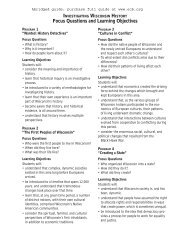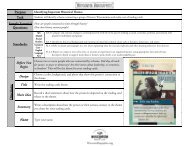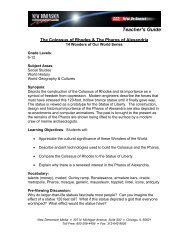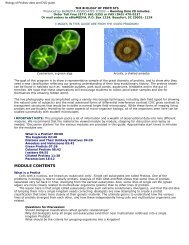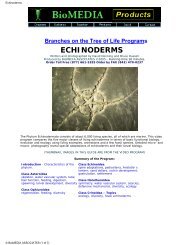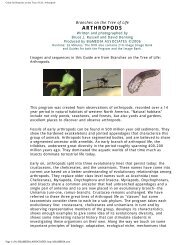layout Molluscs program guide
layout Molluscs program guide
layout Molluscs program guide
You also want an ePaper? Increase the reach of your titles
YUMPU automatically turns print PDFs into web optimized ePapers that Google loves.
Branches on the Tree of Life<br />
<strong>Molluscs</strong><br />
Written and Photographed by David Denning and Bruce J. Russell<br />
Produced by BioMEDIA ASSOCIATES, ©2006<br />
Running Time 18 minutes<br />
The Phylum Mollusca is the second most diverse phylum of living animals, with more than 60,000<br />
known species alive today. <strong>Molluscs</strong> have also left a remarkable fossil record with over 40,000<br />
described extinct species, some going back over 500 million years to early Cambrian times. This<br />
excellent fossil record is largely a result of the hard, calcified shells produced by these extinct<br />
mollusc species.<br />
One of the earliest <strong>Molluscs</strong> groups was the Monoplacophora, which had limpet-like shells,<br />
but a distinctive body with pairs of gills in along the sides of the mantle cavity. This group is<br />
represented by a fossil of Scenella shown in this <strong>program</strong> which was found in the Burgess Shales<br />
of British Columbia. Only a few species of Monoplacophorans, such as the ‘living fossil’ Neopolina,<br />
survive today in very deep ocean basins.<br />
The word ‘mollusc’ means ‘soft-bodied’. The mollusc body is<br />
bilaterally symmetrical. Most <strong>Molluscs</strong> have a muscular foot,<br />
which can take a variety of forms, and is used variously for<br />
crawling, digging, or swimming.<br />
Most molluscs are protected by a hard shell made from<br />
calcium carbonate minerals extracted from the water. The<br />
shell is secreted along a rim of soft tissue called the mantle,<br />
which forms the mantle cavity hiding a delicate set of gills.<br />
While the gills are typically ‘feather-like’ in most species, some<br />
molluscs have modified gills and others exchange oxygen and<br />
carbon dioxide directly through the skin.<br />
Over time, the mollusc body plan has evolved into four main<br />
groups – Chitons (Class Polyplacophora), Gastropods (Class<br />
Gastropoda), Bivalves (Class Bivalva or Pelecypoda) and<br />
Cephalopods (Class Cephalopoda). Other recognized classes<br />
of molluscs include Monoplacophora, Aplacophora, and<br />
Scaphapoda, but these are not covered by this <strong>program</strong>.<br />
Limpet: Ventral view
Branches on the Tree of Life: <strong>Molluscs</strong> p. /6<br />
Chitons (Class Polyplacophora)<br />
A wave-swept rocky shore is a good place to find slow-moving molluscs with eight bony plates.<br />
These are the chitons, members of Class Polyplacophora. The name means, “many -shelled”.<br />
The bony plates are imbedded in leathery tissue covering the animal which is considered to be<br />
part of the mantle. Along the sides of the foot, inside the mantle cavity, is a multi-branched gill for<br />
oxygen uptake.<br />
A chiton’s mouth is equipped with a toothed organ -- a radula. Each tooth is made from crystals<br />
hardened with iron and manganese. The radula acts like a super-hard rasp, to scrape algae off<br />
rocks without wearing down the teeth. The radula action of chitons, limpets and rasping snails<br />
provides a significant contribution to weathering on coastal shores, especially on sandstone rock.<br />
Chiton clamped to rock Chiton Gills Radula of Gumboot Chiton<br />
Chitons are largely herbivores although a few species are able to trap small crustaceans and are<br />
thus carnivores. However, some chitons scrape the living organisms off rocks indiscriminately, so<br />
they are both herbivores and carnivores.<br />
Most chitons live on rocky seashores, where algae is abundant. They are protected from the<br />
smashing waves by their low profile and well armored backs. But in one large chiton, Cryptochiton<br />
stelleri, the armor plating is overgrown by the rubbery red skin, giving it the common name<br />
– gum-boot chiton.<br />
There are about 500 different species of chitons alive today -- all restricted to marine habitats.<br />
Snails, Slugs and Nudibranchs (Class Gastropoda)<br />
Class Gastropoda is the most diverse group of molluscs alive today- with more than 50,000 living<br />
species.<br />
A seashore tide pool is a good place to observe Gastropod molluscs. Gastropoda means “stomach<br />
foot”. The group includes limpets, abalones, and many types snails and slugs. Most gastropod<br />
species are marine, but this group has successfully invaded freshwater and the land, giving rise<br />
to hundreds of terrestrial species. Other groups of molluscs have not been successful on the land,<br />
and only bivalves have had some success in fresh water.<br />
A limpet shows typical gastropod features: the foot, the mantle,<br />
the gill, and the radula, a rasp on a conveyor belt. At low tide,<br />
limpets generally stick to moist crevices and cracks, but when the<br />
tide comes in they crawl about the surfaces of rocks using their<br />
radulas to scrape off algae.<br />
Limpets have a cap-like conical shell, without any indication of<br />
coiling, but many Gastropods have coiled shells with varying<br />
degrees and shapes of coiling. When a snail retracts into its<br />
shell, a kind of trap-door -- the operculum -- helps block out<br />
predators. The operculum is made of proteinaceous or calcereous<br />
material. Even the massive body of the moon snail can be pulled<br />
back into its shell and hidden behind the operculum. When the<br />
tide goes out, or on a hot day on the land, the operculum prevents<br />
water loss from the snail.<br />
Duncecap Limpet<br />
©2006, BioMEDIA ASSOCIATES, http://ebiomedia.com
Branches on the Tree of Life: <strong>Molluscs</strong> p. /6<br />
Snails exhibit a full range of lifestyles. Some snails are herbivores -- competing with limpets for<br />
micro-algae growing on the rocks. Others, such as the barnacle-eating whelk, are predators. The<br />
whelk uses its radula to get inside the barnacle’s shell. Other predators may use modified radula<br />
to capture prey. One example of this is the cone snail which thrusts a poison dart at it’s prey. The<br />
dart is a modified radular tooth.<br />
Black turban radula in action Operculum of Ringed Top-shell Nudibranch Feeding on Sea Pen<br />
The gastropod sub-group known as nudibranchs is almost entirely predatory. The name means<br />
“naked-gilled.” -- naked, because nudibranchs have no protective shell. Many nudibranchs<br />
have a circle of gills around the anus. This group, the dorid nudibranchs, show a pair of fleshy<br />
‘horn-like’ structures on the head, the rhinophores. These are chemical sensors used in sensing<br />
chemicals from food, mates, etc. In general, nudibranchs have very poor vision and their simple<br />
eyes probably provide little image resolution. Nudibranchs in other groups often breathe through<br />
projections on their backs. The body of nudibranchs is straight, without the coiling that is typical of<br />
most gastropods. The straightening is accomplished during development, from a coiled larva.<br />
Nudibranchs may seem to be vulnerable with their exposed soft bodies, but they often derive<br />
protection from the food they eat. Many nudibranchs eat toxic sponges, concentrating poisons<br />
from the sponge --- a borrowed defense against predators. Sponges tend to be armed with<br />
poisonous chemicals because they cannot move, and have no other means to protect themselves.<br />
As they eat poisonous sponges, nudibranchs must be equipped with both the means to avoid<br />
poisoning and the means to hold the poisons in their tissues.<br />
Many nudibranchs in the group, Aeolid nudibranchs, feed on anemones – animals with tentacles<br />
filled with stinging cells. The stinging cells aren’t digested – instead they are transported to<br />
projections on the nudibranch’s back known as cerata. Should a predator take a bite of one of<br />
these stinging-cell-filled nudibranchs, it will get a mouth full of stinging cells and may learn not to<br />
eat the nudibranch. Research indicates that predators learn to avoid the smell of nudibranchs.<br />
The nudibranch, Rostanga pulchra, Aeolidia feeding on anemone Chromodoris magnifica<br />
eats, and lays its eggs on red sponges<br />
Fortunately for human admirers of these gastropods, nudibranchs advertise their distasteful<br />
condition with bright colors that warn off visual predators While this approach works for visual<br />
predators, it is not particularly adaptive against predators that find their prey by touch and smell.<br />
Some nudibranchs either taste or smell very unpleasant to potential predators, which consequently<br />
leave them alone. A few species of nudibranchs, such as the Dendronotid nudibranch shown in<br />
this <strong>program</strong>, have evolved an escape response from predatory sea stars. A type of flexing by the<br />
nudibranch may allow it to swim away from the predator, thus surviving to potentially reproduce<br />
another day.<br />
Nudibranchs are hermaphroditic, with both sexes in one individual. They do not self-fertilize – this<br />
would be a waste of energy compared to simply cloning by asexual reproduction. Instead, they<br />
find a suitable mate (largely through chemical sensing). A few minutes of touching may indicate<br />
©2006, BioMEDIA ASSOCIATES, http://ebiomedia.com
Branches on the Tree of Life: <strong>Molluscs</strong> p. /6<br />
that each mate is receptive. During mating, there is a two-way flow of sperm. This process is<br />
viewed in the <strong>program</strong> through a remarkable nudibranch (the sea-mouse nudibranch, Aeolodia<br />
papillosa) with a transparent penis. Sperm packets can be seen in each penis travelling toward the<br />
opposite mate. Each mate stores the sperm and uses it to fertilize eggs as they are laid.<br />
The eggs are laid in a stream of mucus which forms a jelly-like mass. Thousands to tens of<br />
thousands of eggs are in each egg mass. An individual may lay several egg masses, each with<br />
thousands of individual eggs, that are fertilized with the sperm from one mating, and then may<br />
seek out another mate in preparation for more egg-laying.<br />
Inside the fertilized egg, a small larva develops to a stage with at least one circular band of cilia<br />
around it. These trochophore larvae break free from the egg and swim off into the plankton where<br />
they feed on microscopic algae cells. Within a few days or weeks, they change into a winged larva<br />
with a shell known as a veliger. Shelled veliger occur in the life cycles of most marine snails, sea<br />
slugs, and nudibranchs. But in the case of nudibranchs, the larval shell is lost, and the animal’s<br />
coiled body straightens out. The process is called ‘de-torsion’.<br />
Aeolidia: Hermaphroditic mating Aeolidia with recently-laid egg mass Janolus laying eggs<br />
Nudibranchs are some of the most beautiful animals in marine environments, and have often been<br />
called the ‘butterflies of the sea’. Several thousand species of nudibranchs are distributed around<br />
the world’s oceans in shallow coastal waters.<br />
A different line of gastropods has evolved on the land - the pulmonate gastropods, a group that<br />
includes both land snails, slugs, and many freshwater snails. These molluscs breathe by drawing<br />
air through a hole on the side of the body, (the pneumostome) into a moist internal cavity where<br />
oxygen is picked up. Pulmonate survival depends on remaining sufficiently moist. They are most<br />
active in tropical rainforests, and at night. Slugs and snails are often considered pests in the<br />
garden, where they emerge at night to feed on leafy plants. Gardeners may wish to encourage<br />
garter snakes, which feed on slugs and snails, and they can put out boards where the slugs hide<br />
and can be removed in the morning.<br />
One unusual slug is featured in the <strong>program</strong> - the dromedary slug, so called from the fleshy hump<br />
on the back. When attacked by a predatory snail, this slug has a fascinating escape response that<br />
involves flexing the body rapidly several times, giving the slug its other name – the jumping slug.<br />
Mussels, scallops and clams, CLASS Bivalva<br />
Bivalve molluscs have two shells connected by a hinge.<br />
The group includes some familiar seafood --scallops,<br />
clams, oysters and mussels. The class is also known as<br />
Class Pelecypoda, meaning ‘hatchet foot’.<br />
Mussels can be found on most temperate rocky<br />
shorelines. The California mussel is featured in this<br />
<strong>program</strong>. To secure itself on a rocky seashore, a mussel<br />
creates strong anchor lines called byssus threads. This<br />
<strong>program</strong>s shows the production of a byssus thread as it<br />
is laid down in a groove along the foot. The time-lapse<br />
photography is sped up 10 times, showing the foot<br />
secreting its line, which has first been cemented to a<br />
nearby rock. The byssus anchor system allows mussels<br />
to live on rocks subjected to fiercely pounding waves.<br />
Byssus thread production by mussel foot<br />
©2006, BioMEDIA ASSOCIATES, http://ebiomedia.com
Branches on the Tree of Life: <strong>Molluscs</strong> p. /6<br />
Pink scallops also have byssus threads, but they are short and hold the scallop only temporarily to<br />
the rock. Upon approach of a predatory sea star, scallops forcefully break the threads and swim off<br />
by clapping the two valves together. This swimming motion is reminiscent of false teeth flapping<br />
through the water.<br />
Most bivalves feed by filtering microscopic<br />
organisms drifting in the water. Food-bearing sea<br />
water is brought into the shell by gentle currents<br />
created by the bivalve, and food is captured in<br />
sticky mucous covering the gills. Particles of<br />
dye placed on the gill show the stream of foodtrapping<br />
mucous flowing toward the mouth. The<br />
flow system is created my microscopic hair-like<br />
structures – the cilia – covering the gill.<br />
Most bivalve molluscs live buried in sand or mud;<br />
and use their foot to pull themselves along and<br />
to anchor in. To collect food and oxygen from a<br />
position down in the mud, clams use an extendable<br />
tubular structure, the incurrent siphon. The siphon Bivalve structure and feeding mechanisms<br />
acts like a vacuum line or snorkel, sweeping<br />
are investigated in the mussel.<br />
particles and seawater into the clam. The flow of<br />
water then travels across the food-trapping gills, and leaves the clam via the excurrent siphon.<br />
The opening for the incurrent siphon has finger-like projections that keep out large particles that<br />
might clog the gills. If something distasteful enters the clam, it contracts the siphons, quickly<br />
squirting out the intrusion. Wastes are eliminated through the excurrent siphon.<br />
To reproduce, marine clams and mussels spew eggs and sperm directly into the sea. The fertilized<br />
egg develops into a larva with a circular band of cilia called a trochophore larva. After swimming<br />
in the plankton for a few hours to days, the trochophore transforms into a veliger larva with two<br />
wing-like lobes that drifts and feeds in the open sea.<br />
The veliger will eventually settle to the bottom to become a juvenile clam. Along the way it<br />
develops a foot that first propels the clam by ciliary action, and then later develops the “anchor<br />
and pull” method used by adult clams. In this <strong>program</strong>, dramatic microscope footage of a<br />
transparent juvenile clam reveals the heart, cilia-lined gills, and digestive system that will<br />
eventually elaborate in the adult clam.<br />
Larval development in many freshwater clams and mussels involves a parasitic stage. The larvae<br />
have two tiny valves and are equipped with powerful muscles, and sharp hooks, adaptations for<br />
swimming and grabbing onto passing fish. This <strong>program</strong> shows an experiment where ‘fishy’ water<br />
from an aquarium containing several fish was added to a bowl containing a cluster of freshwater<br />
mussel larvae. The bivalve larvae immediately began to close and open vigorously. In nature,<br />
these snapping larvae would latch on to the fins of passing fish, becoming parasites until they drop<br />
off to take up adult life at the bottom. The system is effective for dispersing the clams around<br />
lakes and upstream in river systems.<br />
Squids, Octopods and Nautiloids (Class CEPHALOPODA)<br />
In one group of molluscs large brains and complex behaviors such as the ability to swim and<br />
rapidly change color have evolved. This group, Class Cephalopoda, includes octopods, nautiloids,<br />
and squids. Cephalopods date back over 400 million years, when Nautiloids and other early<br />
cephalopod groups evolved. A rich fossil record of shelled cephalopods indicates that these<br />
molluscs were successful ocean predators for hundreds of millions of years.The spiral-shelled<br />
ammonoids were particularly successful and were dominant predators for tens of millions of<br />
years, but they were suddenly wiped out by the Cretaceous Extinction event, that also eliminated<br />
the dinosaurs.<br />
The ancient group, the nautiloids, has only a few living representative species. The chambered<br />
nautilus lives in deep tropical waters where it feeds as a scavenger. In this <strong>program</strong> a chambered<br />
nautilus released on a coral reef makes its way back into the abyss. The nautilus controls its<br />
buoyancy by injecting gas into chambers in its shell.<br />
©2006, BioMEDIA ASSOCIATES, http://ebiomedia.com
Branches on the Tree of Life: <strong>Molluscs</strong> p. /6<br />
Members of a different branch of cephalopods, squids and cuttlefish, have a straight shell, rather<br />
than a coiled, chambered one. The shell these molluscs is contained entirely inside the mantle.<br />
Squids and cuttlefish have complex social lives and they observe their world with eyes as complex<br />
as the eyes of birds and mammals.<br />
The best-known cephalopods, the octopods, have lost<br />
their shells completely. Water is sucked into the mantle<br />
cavity through an incurrent opening and then it flows<br />
over the gills. A flap then closes off the mantle and<br />
water is forced out of the funnel, which can be directed<br />
like a hose nozzle. The funnel is used as a jet when<br />
the octopus is threatened. Many octopuses and squids<br />
have ink glands, and they can squirt a cloud of ink to<br />
confuse a threatening predator.<br />
Octopus tentacles have suction discs used to hold<br />
prey and grab the bottom. The rapid color change is<br />
controlled by nerves that change the size of pigment<br />
cells in the skin. A large brain and excellent vision<br />
coordinate these behaviors.<br />
Octopus rubescens<br />
Female octopus of some species live only 1-3 years, and when mature they lay a large clutch of<br />
eggs in a cave which they guard vigorously. In most species, the female dies at this time. The<br />
larval stages of octopods are passed entirely in the egg case which contains ample yolk for<br />
development to the juvenile stage. Upon hatching, the miniature juveniles swim off to disperse<br />
into new habitats.<br />
Evolution and Diversity of <strong>Molluscs</strong><br />
With over 100,000 species, Phylum Mollusca is second only to the arthropods in diversity. <strong>Molluscs</strong><br />
are particularly successful in the sea, living in marine habitats ranging from deep water to coral<br />
reefs, to rocky shores, to muddy bays. They have also moved into fresh water and to a limited<br />
degree, on to the land.<br />
The evolution of molluscs can be glimpsed from their early larvae. Marine chitons, gastropods and<br />
bivalves all have a free-swimming larva ringed with cilia – the trochophore. It’s the same type of<br />
larva found in marine annelid worms – indicating that molluscs and annelids are close relatives on<br />
the tree of life.<br />
But annelid trochophores develop by adding multiple segments --- while mollusc trochophores<br />
develop differently. Marine clam and snail trochophores, for example, develop into free-swimming<br />
veliger larvae, eventually settling down and growing into soft-bodied adults.<br />
©2006, BioMEDIA ASSOCIATES, http://ebiomedia.com







